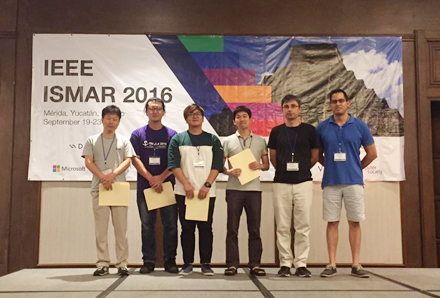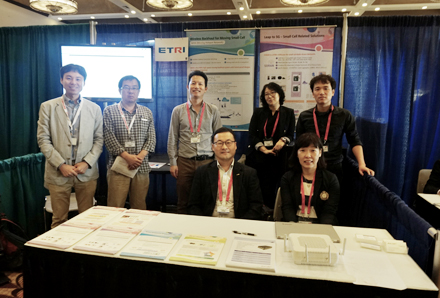
ETRI Wins at IEEE Symposium on Augmented Reality
With the recent Pokemon Go Craze around the world, Nintendo’s mobile game based on augmented reality, increasing attention is being directed to augmented reality services to match virtual objects seamlessly in real-life environments. Amidst this latest trend, a team of researchers from ETRI and Hanyang University received an award at an international technology symposium held by the IEEE (Institute of Electrical and Electronics Engineers).
The research team participated in the IEEE International Symposium on Mixed and Augmented Reality, held in late September 2016, in Merida, Mexico. ISMAR was organized by the IEEE, the world’s renowned academic organization, and sponsored by global multinational companies, such as Microsoft, Intel, and Qualcomm.
The section in which ETRI was awarded involved camera tracking technology, one of the most essential technologies in the area of augmented reality. In order to incorporate virtual objects in the intended location within images of real life, it is necessary to accurately calculate the location of the camera and directional data. By realizing such functions, the technology serves as an important element to enhance the quality of augmented-reality content.
For the symposium, ETRI organized a joint team with researchers at Hanyang University’s mixed reality lab. Those members who made a significant contribution to the award-winning work include Dr. Jun-seong Bang and Dr. Dong-chun Lee at ETRI’s Game Technology Research Section, and Mr. Jeong-sik Park (doctoral course) and Chang-seob Kim studying at Hanyang University. They made an outstanding team effort for a few days in preparation for demonstrating outstanding coding performance at the symposium. Based on thorough scenarios, they finally produced content suitable for the symposium’s mission “Hide & Seek.”
The Game Technology Research Section of ETRI’s Creative Content Research Division is currently conducting a project to develop realistic e-leisure content service technology connected to the real world, with support from the Ministry of Culture, Sports and Tourism and Korea Creative Content Agency. By continuously advancing the developed technologies, ETRI will apply the technologies to augmented reality-based content services in an effort to develop another outstanding augmented reality game.

ETRI’s 5G Technology Receives Spotlight in the United States
Participating in the Small Cell Forum held in Dallas, United States, on November 1st and 2nd, ETRI demonstrated its latest 5G technologies and drew significant attention from other participants. In partnership with smaller businesses to which it had transferred its technologies, ETRI jointly exhibited MHN (mobile hotspot network) technology and small-cell software technology, a subset of the latest 5G technologies from current research and development efforts.
As part of the Korean government’s 5G development projects, the MHN technology provides 100 times faster data transmission speed than the existing wireless backhaul system based on the existing Wibro networks established for underground subways, by using the untapped millimeter wave of 30-300 GHz. ETRI also announced that it has begun to develop MHN-E (MHN-Evolution) technology to transmit data at a maximum rate of 10 Gbps. It further explained the Wi-Fi service available within vehicles and service expansion to mobile small cells for LTE/LTE-A.
Mr. Prabhakar Chitrapu, the chief technology officer at AT&T, showed significant interest in eMBMS, the latest small-cell technology developed by ETRI. This technology can provide broadcasting services to a specific region through a single wireless channel based on the LTE service from a small-cell base station, and also can be used for disasters and special military communications. “This exhibition affirmed the extraordinary quality of the MHN and small cell technologies developed by ETRI,” said Dr. Yeong-jin Kim, Director of the Mobile Application Research Department. “After participating in the event with SMEs, we witnessed that our technological achievements are likely to open a new market and opportunities in North America.”
Founded in 2009, the Small Cell Forum is now a leading organization, with more than 60 mobile carriers around the world such as AT&T and NTT Docomo, as well as around 70 manufacturers including Ericsson, Samsung Electronics, and Huawei as members.
